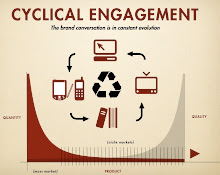In thinking about the notion of
transmedia planning (engagement marketing) and the thoughtful expositions drawn out in Henry Jenkins' book,
Convergence Culture, it struck me that the delicate practice of developing sound brand strategy and successful tactics is sort of like running through a marshland. Danny Dreyer's
ChiRunning concept seems to be an interesting analogy/discipline for how we can navigate the wild and wooly landscape and align consumers with touch-points that keep them in safe harbor from the pratfalls of technology inhibition or "message envy". Let's explore.
There are four primary tenets to ChiRunning:
- Run injury free
- Increase efficiency with a mid-foot strike
- Increase your speed while reducing the effort
- Finish a pain-free marathon and look forward to running again
So, starting with the first tenet, running injury free, let's take this to mean that we can remove or reduce any transgressions relating to past brand experiences, i.e. "brand baggage". This is the first real thrust into reputation management. With a new campaign or open-ended initiative, we have an opportunity to wipe the slate clean and establish new parameters for conversational development, primarily through full disclosure and transparency. Further, by allowing consumers to become stakeholders, a weight is lifted in having to prescribe messaging or push sales. A new story is about to unfold, and it evolves through channels that are organic to idea- and experience-sharing, off- or online.
Now we've re-entered the landscape, and in increasing efficiency with a mid-foot strike, we are effectively riding the wave of mid-tail content and respective utilities that are on offer for these consumer advocates. Text, video, photos and other forms of social currency are gladly created and bartered, and the brand is providing tools to enable these experiences. The groundswell surges. Opinions take shape. In some cases, new product ideas are being developed. Most importantly, brand advocates are creating communities that begin to dictate the ebb-and-flow of branded conversation, and the content being created in and around that conversation hits specific focal points within the tail that raise the bar on quality.
At this next stage, we're increasing the speed at which these dialogues are being had and reducing the effort in guiding them. The relationship with the brand is becoming intimate. Social rules have been implemented. Crowdsourcing generates new insights, yet keeps the rules in check, allowing the brand to mature at a steady pace. Most remarkable, the brand, in taking on this new life and perspective, is responsible for an invisible parallel that puts people who share common interests in line with one another. The balance is undeniable.
Finally, we find ourselves, as brand stewards, running a pain-free marathon, exploring different media avenues, and protected by enough brand equity to be able to experiment without great risk. We can stage that event, Tweet-Up or conference podcast, or form that Ning group; if nothing else, we can see where we stand within specific environments. Our humility and transparency keeps us alive and well. And we look further to the road ahead...we look forward to running again.
Having made the traverse, we can now sit back, reflect and plan the next adventure, knowing that we may not necessarily be able to predict outcomes, but that we can adapt to them and shift our perception within the landscape at any time, and at any given place.







